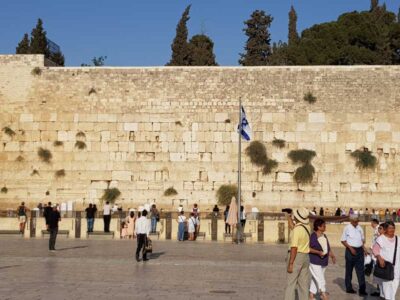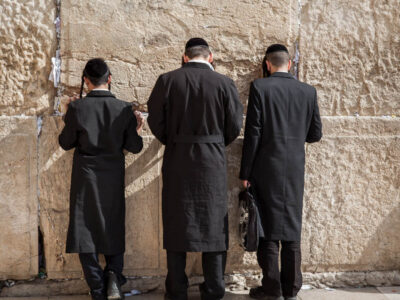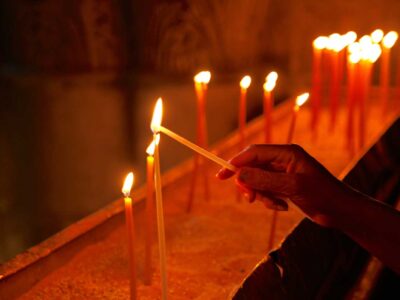The Western Wall - the Kotel
The Western Wall (often shortened to the Kotel or Kosel), known in the West as the Wailing Wall is an ancient limestone wall in the Old City of Jerusalem. It is a relatively small segment of a far longer ancient retaining wall, known also in its entirety as the "Western Wall". The wall was originally erected as part of the expansion of the Second Jewish Temple begun by Herod the Great, which resulted in the encasement of the natural, steep hill known to Jews and Christians as the Temple Mount, in a huge rectangular structure topped by a flat platform, thus creating more space for the Temple itself, its auxiliary buildings, and crowds of worshipers and visitors.
In one of several varying Muslim traditions, it is the site where the Islamic Prophet Muhammad tied his winged steed, al-Buraq, on his Isra and Mi'raj to Jerusalem before ascending to paradise, and constitutes the western border of al-Haram al-Sharif ("the Noble Sanctuary"), or the Al-Aqsa compound.
The Western Wall's holiness in Judaism is a result of its proximity to the Temple Mount. Because of the Temple Mount entry restrictions, the Wall is the holiest place where Jews are permitted to pray, though the site of the Holy of Holies, the most sacred site in the Jewish faith, lies behind it. The original, natural, and irregular-shaped Temple Mount was gradually extended to allow for an ever-larger Temple compound to be built at its top. This process was finalized by Herod, who enclosed the Mount with an almost rectangular set of retaining walls, made to support the Temple platform and using extensive substructures and earth fills to give the natural hill a geometrically regular shape. On top of this box-like structure, Herod built a vast paved platform that surrounded the Temple. Of the four retaining walls, the western one is considered closest to the former Holy of Holies, which makes it the most sacred site recognized by Judaism outside the previous Temple Mount platform.
Just over half the wall's total height, including its 17 courses located below street level, dates from the end of the Second Temple period, and is commonly believed to have been built by Herod the Great starting in 19 BCE, although recent excavations indicate that the work was not finished by the time Herod died in 4 BCE. The very large stone blocks of the lower courses are Herodian, the courses of medium-sized stones above them were added during the Umayyad period, while the small stones of the uppermost courses are of more recent date, especially from the Ottoman period.
The term Western Wall and its variations are mostly used in a narrow sense for the section traditionally used by Jews for prayer; it has also been called the "Wailing Wall", referring to the practice of Jews weeping at the site over the destruction of the Temples. During the period of Christian Roman rule over Jerusalem (ca. 324–638), Jews were completely barred from Jerusalem except on Tisha B'Av, the day of national mourning for the Temples, and on this day the Jews would weep at their holy places. The term "Wailing Wall" was thus almost exclusively used by Christians, and was revived in the period of non-Jewish control between the establishment of the British Mandate in 1920 and the Six-Day War in 1967. The term "Wailing Wall" is not used by religious Jews, and increasingly not by many others who consider it derogatory.
Church of the Holy Sepulchre
The Church of the Holy Sepulchre is a church in the Christian Quarter of the Old City of Jerusalem. According to traditions dating back to the 4th century, it contains the two holiest sites in Christianity: the site where Jesus was crucified, at a place known as Calvary or Golgotha, and Jesus's empty tomb, where he is believed by Christians to have been buried and resurrected. Each time the church was rebuilt, some of the antiquities from the preceding structure were used in the newer renovation. The tomb itself is enclosed by a 19th-century shrine called the Aedicule. The Status Quo, an understanding between religious communities dating to 1757, applies to the site.
Within the church proper are the last four stations of the Cross of the Via Dolorosa, representing the final episodes of the Passion of Jesus. The church has been a major Christian pilgrimage destination since its creation in the 4th century, as the traditional site of the resurrection of Christ, thus its original Greek name, Church of the Anastasis ('Resurrection').
Control of the church itself is shared, a simultaneum, among several Christian denominations and secular entities in complicated arrangements essentially unchanged for over 160 years, and some for much longer. The main denominations sharing property over parts of the church are the Roman Catholic, Greek Orthodox and Armenian Apostolic, and to a lesser degree the Coptic Orthodox, Syriac Orthodox, and Ethiopian Orthodox.
Following the siege of Jerusalem in AD 70 during the First Jewish–Roman War, Jerusalem had been reduced to ruins. In AD 130, the Roman emperor Hadrian began the building of a Roman colony, the new city of Aelia Capitolina, on the site. Circa AD 135, he ordered that a cave containing a rock-cut tomb[d] be filled in to create a flat foundation for a temple dedicated to Jupiter or Venus. The temple remained until the early 4th century.
Construction (4th century)
After allegedly seeing a vision of a cross in the sky in 312, Constantine the Great began to favor Christianity, signed the Edict of Milan legalising the religion, and sent his mother, Helena, to Jerusalem to look for Christ's tomb. With the help of Bishop of Caesarea Eusebius and Bishop of Jerusalem Macarius, three crosses were found near a tomb; one which allegedly cured people of death was presumed to be the True Cross Jesus was crucified on, leading the Romans to believe that they had found Calvary. Constantine ordered in about 326 that the temple to Jupiter/Venus be replaced by a church. After the temple was torn down and its ruins removed, the soil was removed from the cave, revealing a rock-cut tomb that Helena and Macarius identified as the burial site of Jesus.[18][19] A shrine was built, enclosing the rock tomb walls within its own.
In 327, Constantine and Helena separately commissioned the Church of the Nativity in Bethlehem to commemorate the birth of Jesus.
The Church of the Holy Sepulchre, planned by the architect Zenobius, was built as separate constructs over the two holy sites: a rotunda called the Anastasis ("Resurrection"), where Helena and Macarius believed Jesus to have been buried, and across a courtyard to the east, the great basilica, an enclosed colonnaded atrium (the Triportico, sometimes called the Martyrium) with the traditional site of Calvary in one corner. The church was consecrated on 13 September 335. The Church Of The Holy Sepulchre site has been recognized since early in the 4th century as the place where Jesus was crucified, buried, and rose from the dead.
Dome of the Rock
The Dome of the Rock is an Islamic shrine located on the Temple Mount in the Old City of Jerusalem, a site also known to Muslims as the al-Haram al-Sharif or the Al-Aqsa Compound. Its initial construction was undertaken by the Umayyad Caliphate on the orders of Abd al-Malik during the Second Fitna in 691–692 CE, and it has since been situated on top of the site of the Second Jewish Temple (built in c. 516 BCE to replace the destroyed Solomon's Temple), which was destroyed by the Romans in 70 CE. The original dome collapsed in 1015 and was rebuilt in 1022–23. The Dome of the Rock is the world's oldest surviving work of Islamic architecture.
Its architecture and mosaics were patterned after nearby Byzantine churches and palaces, although its outside appearance was significantly changed during the Ottoman period and again in the modern period, notably with the addition of the gold-plated roof, in 1959–61 and again in 1993. The octagonal plan of the structure may have been influenced by the Byzantine-era Church of the Seat of Mary (also known as Kathisma in Greek and al-Qadismu in Arabic), which was built between 451 and 458 on the road between Jerusalem and Bethlehem.
The Foundation Stone (or Noble Rock) that the temple was built over bears great significance in the Abrahamic religions as the place where God created the world as well as the first human, Adam. It is also believed to be the site where Abraham attempted to sacrifice his son, and as the place where God's divine presence is manifested more than in any other place, towards which Jews turn during prayer. According to Jewish tradition and to the consensus theory in modern scholarship, the Holy of Holies stood directly on the Foundation Stone. The site's great significance for Muslims derives from traditions connecting it to the creation of the world and the belief that the Night Journey of Muhammad began from the rock at the centre of the structure.
Designated by UNESCO as a World Heritage Site, it has been called "Jerusalem's most recognizable landmark"along with two nearby Old City structures: the Western Wall and the "Resurrection Rotunda" in the Church of the Holy Sepulchre. It is the earliest archaeologically attested religious structure to be built by a Muslim ruler and the building's inscriptions contain the earliest epigraphic proclamations of Islam and of the Islamic prophet Muhammad; the inscriptions proved to be a milestone, as afterward they became a common feature in Islamic structures and almost always mention Muhammad. The Dome of the Rock remains a "unique monument of Islamic culture in almost all respects", including as a "work of art and as a cultural and pious document", according to historian Oleg Grabar.


















